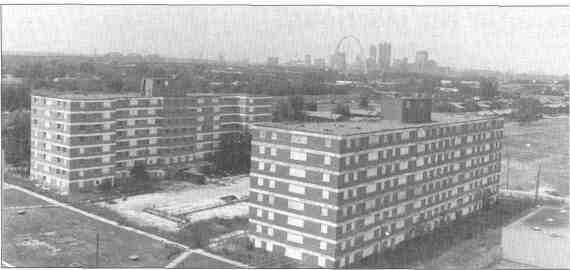 |
Home | Search | Browse | About IPO | Staff | Links |
 |
Home | Search | Browse | About IPO | Staff | Links |
Innovations

Photo courtesy of Charles Jefferson, ESLHA and Kennedy Associates
| The Orr-Weathers housing project in East St. Louis stood boarded up and abandoned for 12 years before being demolished to make room for new, less congested public housing. |
East St. Louis leads new trend away from high-rise public housing
The U.S. Department of Housing and Urban Development and the East St. Louis Housing Authority demolished the Orr-Weathers Development, two eight-story public housing high-rise apartment buildings. It's the first time high-rise low-income housing has been torn down in Illinois, and other local housing authorities across the state are taking note.
Meanwhile, Chicago Housing Authority Chairman Vincent Lane is trying to convince the federal government to allow the CHA to borrow up to $1 billion to replace low-income high-rise developments in that city.
HUD's Midwest representative, Edwin Eisendrath, says the CHA has been awarded a $50 million demonstration grant to begin taking down some of the Cabrini-Green high-rise apartments. And Springfield was awarded nearly $20 million to "transform" some of its John Hay Homes, which are not high-rises but are so congested they are also unsafe and unlivable, says Eisendrath.
The Orr-Weathers high-rises, built in 1962, housed their last tenants in 1982. A HUD representative says they represent "a real failure of government at all levels." The 214 units were torn down in September.
East St. Louis sits across the Mississippi River from St. Louis, which was the site of one of the nation's first high-rise public housing projects. The Pruitt-Igo apartment towers were also the first large-scale public housing in the country to fall to the demolition experts' explosives.
The high-rise housing in East St. Louis will be replaced with duplexes, row houses and single-family structures. A total of 668 replacement units are planned at an estimated cost of $72 million.
Beverley Scobell
SROs: Another approach to housing the homeless
To the taxpayer homelessness is expensive because many of the homeless end up in shelters, hospitals, treatment programs and prisons. But Lakefront Single Room Occupancy Corp., a nonprofit housing developer in Chicago, aims to provide affordable housing along with supporting social services to poor and homeless single adults.
Lakefront buys and converts run-down and vacant single room occupancy (SRO) buildings and turns them into housing. Each apartment is fully furnished. Most include kitchenettes and many have private baths.
Lakefront offers on-site social services at each building to provide medical and mental health treatment, alcohol and drug rehabilitation and employment services. According to Lakefront, combining homes and social services helps prevent problems that force many homeless people out into the street.
By mid-1995, 615 single adults will have housing. Lakefront's goal is to create 1,000 rehabilitated units of SRO housing by 1996.
Tenants, others filling cultural, arts gaps in public housing
Tenants of Springfield's John Hay Homes public housing, their children and some Sangamon State University students are converting unused housing units into a children's library. What's unique about this children's library, says Mike Townsend, professor of Child, Family and Community Services at Sangamon State, Springfield, is that the children are doing much of the work themselves - painting, putting up shelves, sorting books - and they will run the library when it's ready. "They will open the library for business each day, they will set the schedule, make decisions on how to shelve the books and in fact decide how they want to run their library," says Townsend.
There are plans to add a computer room, an activity area and an adult reading room. Adults are helping to get the project started, but once it's running successfully, the adults will have to follow the kids' rules on using their library, says Townsend.
Meanwhile, in Chicago an influential community group is funding an arts program for 400 young people. The Northern Horizon Cultural Arts Program, provided through Demicco Youth Services, is offering dance, music, ceramics, art therapy and a youth theater workshop in the Cabrini-Green public housing complex. Funded by the Chicago Community Trust as part of its Children, Youth and Families Initiative, the program gives the young people of the high-rises and nearby neighborhoods an outlet for their creative talent and an alternative to involvement in drugs, alcohol and gangs.
The Chicago Community Trust is helping to fill a gap that often follows problems in the public school system. When school boards have to cut their budgets, the programs that seem the most vulnerable are the arts. Bonnay Webster of Demicco Youth Services Inc., a community-based organization serving the Cabrini-Green/Near North Side neighborhoods, has witnessed cuts in the Chicago school system. "Most inner city schools have decreased their budgets for music and recreation," she says.
4 / December 1994 / Illinois Issues
|
Sam S. Manivong, Illinois Periodicals Online Coordinator Illinois Periodicals Online (IPO) is a digital imaging project at the Northern Illinois University Libraries funded by the Illinois State Library |